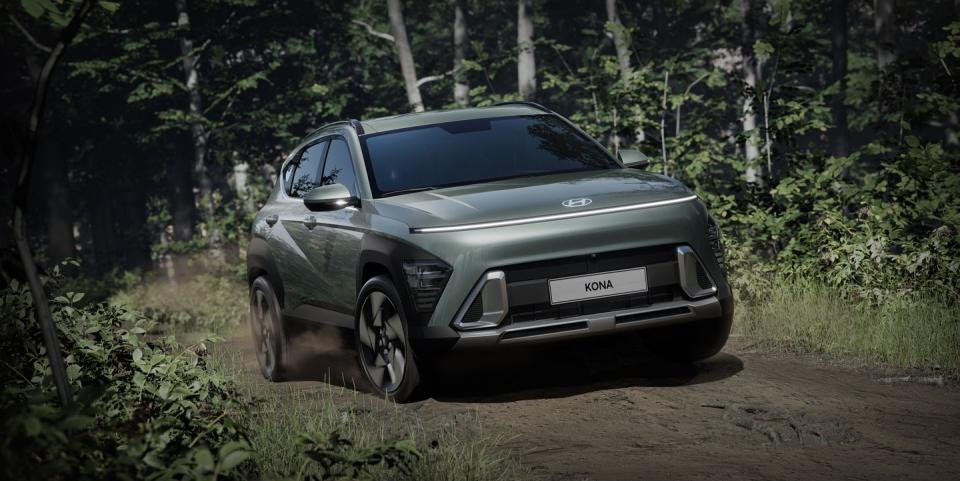The 2024 Hyundai Kona Is Bigger, Bolder, and Column Shifted

Hyundai stretches the Kona 5.9 inches in length and 2.4 inches in wheelbase for the next generation.
The Korean automaker says it designed the EV variant first, then modified the design to accommodate the internal-combustion powertrains.
The new Kona will feature EV, hybrid, and N-line powertrains, but Hyundai isn’t sharing specifics on size or outputs.
Hyundai ushered its compact Kona crossover into the world in 2017, as a 2018 model. The Kona has evolved over the years and helped take Hyundai into the world of battery-electric vehicles, then expanded the over-the-top N portfolio.
Now, it appears the days are numbered for the current Kona, as information about the redesigned second generation is trickling out. Hyundai says it kicked off its next-gen Kona design with the EV models, and then adapted that design for the internal-combustion variants. Adding to that, the new Kona is larger, bolder, and more upscale.
The Korean automaker hasn’t mentioned which powertrains will hit the new Kona, only confirming that we can expect an EV, hybrid, and N model. It’s hard to say what engines Hyundai will borrow from its roster, but we hope the N-variant sticks with the hilariously fun 2.0-liter turbocharged I4. As for its EV offerings, we assume the Kona will rely on hardware from its popular Ioniq line of EVs.
While powertrain details are limited, there is some concrete news about the Kona’s new shape. The second-generation Kona will be 5.9 inches longer than the currently available model, and roughly an inch wider. Taking advantage of the extra length, Hyundai stretched the Kona’s wheelbase 2.4 inches. This stretched crossover should have more room for passengers between the axles, along with extra cargo space.
The upcoming Kona shares some of its futuristic styling with Hyundai's popular Ioniq 5 EV, although with a few more curves and soft edges. The Ioniq 5 will remain quite a bit larger, so the new Kona will still be Hyundai’s entry-level EV. The smooth fascia with an expansive signature light bar in the nose gives the new Kona a unique and likely polarizing design.
Inside, the re-engineered Kona follows the growing trend of sharp creases in sheet metal, while leaning into a future-forward approach with ambient lighting and a pair of 12.3-inch infotainment screens sitting on the dash. The most important interior change might be the switch to a column-mounted shifter.
Hyundai says we can expect more details closer to the vehicle’s launch, sometime in 2023. As for price, we’ll have to wait for that, too. In this time of rampant inflation, it’s likely the sticker price of $23,285 for the outgoing model won’t carry over.
The Kona is an important entry in the (very crowded) small crossover segment, where the Ford Bronco Sport and Volkswagen Taos are newer and are outselling the Kona. Through the first three quarters this year, Hyundai sold 45,680 Konas, down 46% from the same period in 2021, according to Wards Intelligence data. Leading the segment was the Subaru Crosstrek, with 115,344 deliveries, followed by the Honda HR-V (92,555 units).
What do you think of this next-generation Kona? Tell us your thoughts below.

 Yahoo Autos
Yahoo Autos 